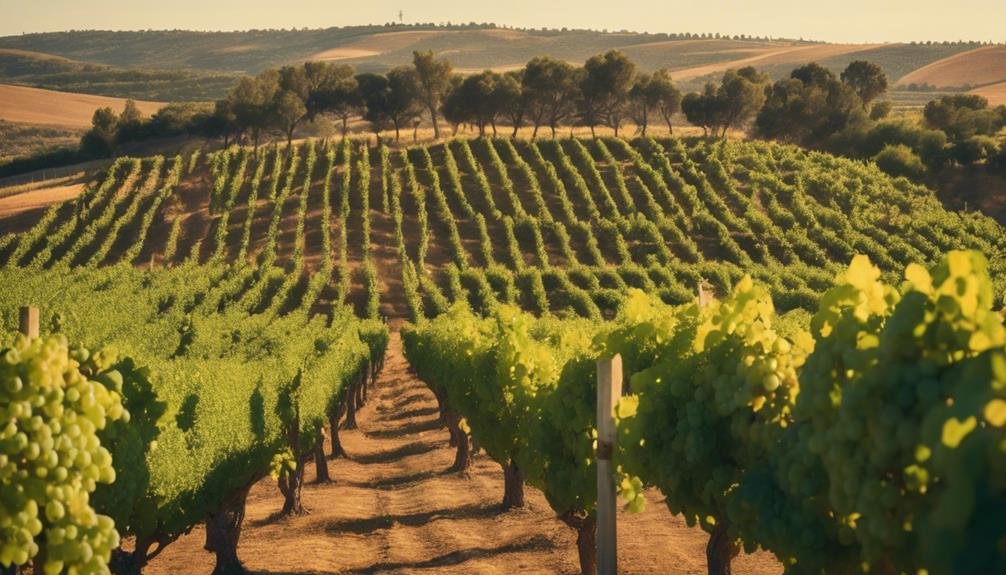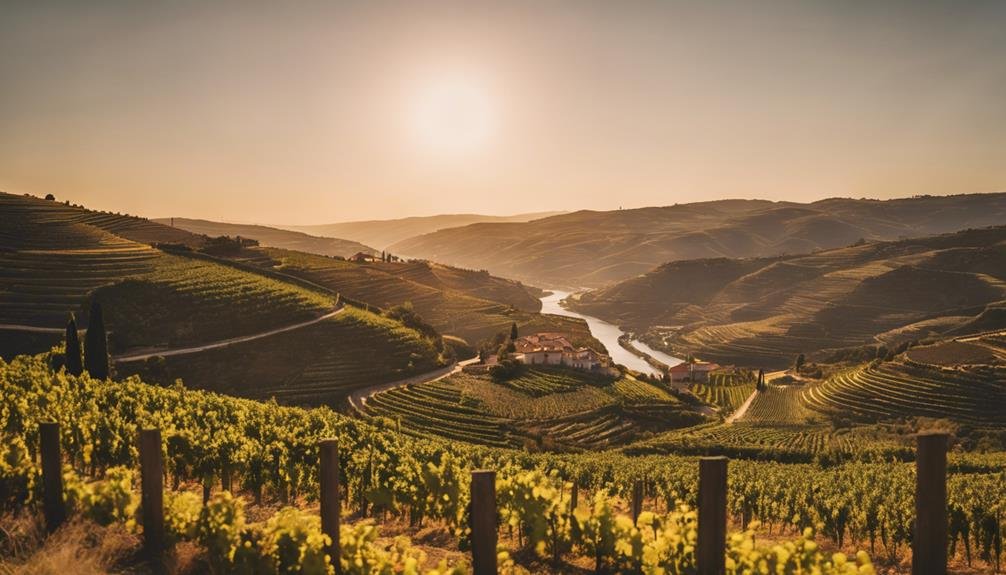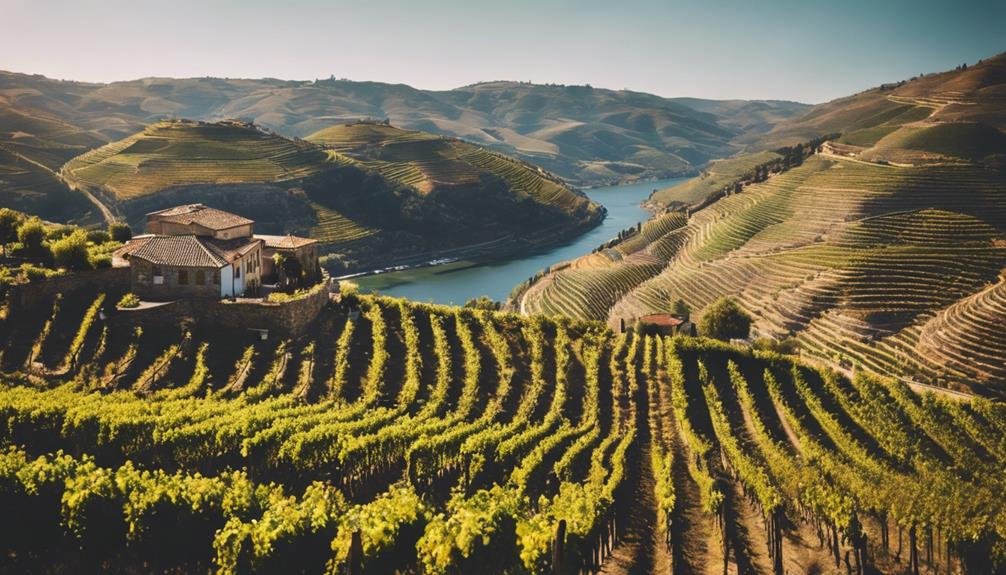Portugal's wine regions stand out for their diversity, from the exceptional aging potential of Douro wines to the light and invigorating taste of Minho (Vinho Verde) wines, pairing perfectly with seafood. Alentejo's Tinto and Branco Alentejo wines offer distinctive flavors from a terroir rich in clay and limestone. Indigenous grape varieties like Touriga Nacional and Alvarinho shape the unique flavors of Portuguese wines. Pico Island and Madeira add to this diversity, offering golden Verdelho and fortified wines. Explore Portugal's vibrant wine culture, rooted in tradition yet embracing modern techniques for a truly unique experience.
Douro Region Wines
Renowned for their exceptional aging potential attributed to the intricate development of tannins and acidity, wines from Portugal's Douro Region epitomize sophistication and complexity in the world of winemaking.
Exploring Douro's terroir reveals high-altitude vineyards with rugged soils of decomposing granite and schist, contributing to the unique character of Douro wines.
This region's wines, known for their aging potential, showcase a harmonious balance between tannins and acidity, allowing them to evolve gracefully over time.
The diverse range of grape varieties grown in the Douro, such as Touriga Nacional and Touriga Franca, further adds to the complexity and depth of these wines.
With a rich history and tradition of winemaking, Douro wines continue to captivate connoisseurs with their exceptional quality and aging capabilities.
Minho (Vinho Verde) Wines
Exploring the vibrant wine landscape of Portugal, the focus now shifts to the distinctive wines of the Minho region, known for its Vinho Verde varieties. Vinho Verde, meaning 'green wine,' encompasses Branco and Rosado varieties, offering a light and invigorating taste with a slight effervescence.
This wine pairs excellently with seafood, salads, and Asian cuisine, making it a versatile choice for various dishes. The region boasts a range of grape varieties such as Alvarinho, Loureiro, and Trajadura, contributing to the unique flavors of Vinho Verde.
Typically consumed young, these wines showcase bright acidity and fruity notes, best enjoyed within a year or two of production. With its regional variations and youthful appeal, Vinho Verde's aging potential lies in preserving its crisp and lively character.
Alentejo Region Wines

The Alentejo region in Portugal is characterized by its diverse range of wines, including Tinto Alentejo and Branco Alentejo varieties, known for their distinct flavors and regional characteristics.
The Alentejo terroir, rich in clay and limestone soils with a warm climate, plays a significant role in shaping these wines. Winemaking techniques in Alentejo often combine traditional methods with modern practices, resulting in high-quality and balanced wines.
This region is home to several indigenous grape varieties such as Aragonez, Trincadeira, and Antão Vaz, which thrive in the Alentejo terroir, contributing to the unique flavors of Alentejo wines.
The combination of terroir, winemaking techniques, and indigenous grape varieties makes Alentejo wines a true reflection of the region's identity and heritage.
Prominent Grape Varieties in Portugal
Prominent among the diverse grape varieties found in Portugal's wine regions are indigenous types that play a significant role in shaping the unique flavors and characteristics of Portuguese wines. These indigenous varietals, combined with modern winemaking techniques, contribute to the complexity and quality of Portuguese wines. Below is a table showcasing some of the most notable grape varieties used in Portugal:
| Red Grapes | White Grapes |
|---|---|
| Touriga Nacional | Alvarinho |
| Baga | Fernão Pires |
| Castelão | Arinto |
| Trincadeira | Encruzado |
These varieties are meticulously cultivated and carefully blended to produce a wide range of wines that reflect the rich heritage and innovation of Portugal's winemaking industry.
Unique Portuguese Wine Regions

In highlighting the diverse viticulture of Portugal, the country's unique wine regions stand out as distinct terroirs that contribute to the richness and variety of Portuguese wines.
Pico Island's vineyards, recognized by UNESCO, produce golden, viscous Verdelho wine in a stunning setting.
Madeira, with a rich history as a fortified wine, offers a unique tasting experience cherished by wine enthusiasts worldwide.
These regions showcase the exceptional diversity of Portuguese winemaking, with Pico Island's vineyards and Madeira's historical significance adding depth and character to the country's wine landscape.
The wines from these regions carry a sense of tradition and terroir that make them truly special in the world of wine.
Frequently Asked Questions
What Are the Traditional Food Pairings for Wines From the Tejo Region?
Traditional food pairings for wines from the Tejo region include hearty dishes like grilled meats, stews, and flavorful cheeses such as Azeitão or Castelo Branco. Tejo wine festivals and food tours offer immersive wine and cheese pairing experiences.
How Does the Climate in Beira Interior Influence the Style of Wines Produced?
The climate in Beira Interior influences wine style through its high altitudes and temperature fluctuations. This unique environment enhances the red-fruit flavors and herbaceous notes in red wines, while white wines exhibit a lean profile with chalky minerality, reflecting the region's soil composition and grape varieties.
Are There Any Specific Winemaking Techniques Used in Bairrada to Enhance Baga Grapes?
In Bairrada, winemakers employ unique fermentation techniques and soil composition to enhance the Baga grape. Special aging processes and meticulous harvesting methods are utilized to craft aromatic sparkling wines, like those from Luis Pato, and light-bodied red wines from Niepoort.
What Makes the Wines From Madeira and Pico Island so Unique Compared to Mainland Portuguese Wines?
Madeira & Pico Island wines' uniqueness lies in their terroir and aging process. Madeira's fortified wines benefit from high heat aging, while Pico's volcanic soil grants Verdelho grapes distinct flavors, making them stand out.
Can You Recommend a Lesser-Known Portuguese Grape Variety That Wine Enthusiasts Should Try?
Exploring indigenous and underrated grape varieties in Portugal reveals hidden gems in the country's wine scene. Wine enthusiasts should try the Baga grape from Bairrada, known for its aromatic sparkling wines and structured reds with unique character.
Conclusion
To sum up, Portugal's diverse wine regions offer a rich tapestry of flavors and traditions that showcase the unique terroir and winemaking heritage of the country.
From the historic Douro Region to the vibrant Minho (Vinho Verde) Region and the robust wines of the Alentejo Region, each area presents a distinct character and quality that reflects Portugal's rich viticultural landscape.
As we explore the nuances of grape varieties and wine regions, we unravel the enchanting essence of Portuguese wine culture, making it a truly remarkable experience.
